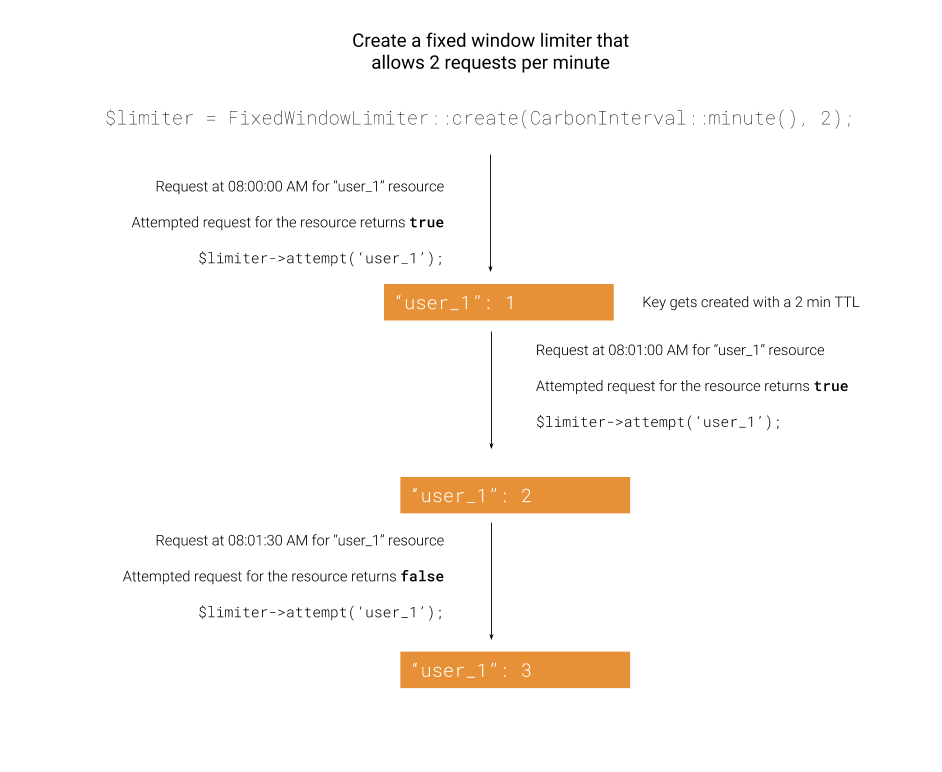https://github.com/beyondcode/laravel-fixed-window-limiter
https://github.com/beyondcode/laravel-fixed-window-limiter
Last synced: 7 months ago
JSON representation
- Host: GitHub
- URL: https://github.com/beyondcode/laravel-fixed-window-limiter
- Owner: beyondcode
- License: mit
- Archived: true
- Created: 2019-04-06T11:24:13.000Z (about 6 years ago)
- Default Branch: master
- Last Pushed: 2020-01-28T08:45:07.000Z (over 5 years ago)
- Last Synced: 2024-08-05T09:17:38.786Z (11 months ago)
- Language: PHP
- Size: 11.7 KB
- Stars: 68
- Watchers: 7
- Forks: 0
- Open Issues: 0
-
Metadata Files:
- Readme: README.md
- Changelog: CHANGELOG.md
- Contributing: CONTRIBUTING.md
- License: LICENSE.md
Awesome Lists containing this project
README
# Fixed Time Window Rate Limiter for Laravel
[](https://packagist.org/packages/beyondcode/laravel-fixed-window-limiter)
[](https://travis-ci.org/beyondcode/laravel-fixed-window-limiter)
[](https://scrutinizer-ci.com/g/beyondcode/laravel-fixed-window-limiter)
[](https://packagist.org/packages/beyondcode/laravel-fixed-window-limiter)
This package allows you to easily create and validate rate limiting using the fixed window algorithm.
This package makes use of Redis' atomic requests.

## Installation
You can install the package via composer:
```bash
composer require beyondcode/laravel-fixed-window-limiter
```
## Usage
You can create a new limiter instance by calling the `create` method and pass it a CarbonInterval that represents the window of time, that will be used for the limiter.
The second argument is the maximum number of requests/attempts that your limiter will accept in that given time frame.
``` php
$limiter = FixedWindowLimiter::create(CarbonInterval::second(2), 2);
```
### Running attempts against your limiter
Once your limiter is created, you can perform attempts against it to see if the call is within the usage limits that you specified.
Since your limiter can be used for multiple resources, you need to pass the resource that you want to attempt the call for in the `attempt` method call.
```php
$limiter->attempt('user_1');
```
### Getting the usage count
When you want to read the number of attempts that were made for a given resource, you may call the `getUsage` method.
**Note:** This method will not return the number of attempts, but only the number of successful attempts. Use the `getRealUsage` method, if you want to see all attempts, including those that were rejected.
```php
$count = $limiter->getUsage('user_1');
```
Or as mentioned, to get the real usage of all attempts for the resource:
```php
$count = $limiter->getRealUsage('user_1');
```
### Reset the limiter
If you want to reset the attempts for a specific resource, you may call the `reset` method on the limiter instance. This will reset the TTL to the given time frame and re-allow new attempts.
```php
$limiter->reset('user_1');
```
### Additional data
Sometimes you might want to store additional data inside of the resource hash in Redis. You can pass the initial data to the `reset` method.
```php
$limiter->reset('user_1', [
'key' => 'value'
]);
```
In order to retrieve the data, you may use the `getAdditionalData` method.
```php
$value = $limiter->getAdditionalData('user_1', 'key');
```
### Testing
``` bash
composer test
```
### Changelog
Please see [CHANGELOG](CHANGELOG.md) for more information what has changed recently.
## Contributing
Please see [CONTRIBUTING](CONTRIBUTING.md) for details.
### Security
If you discover any security related issues, please email [email protected] instead of using the issue tracker.
## Credits
- [Marcel Pociot](https://github.com/mpociot)
- [All Contributors](../../contributors)
## License
The MIT License (MIT). Please see [License File](LICENSE.md) for more information.